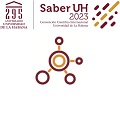Ponente
Descripción
Cationic lipid vesicle mediated gene transfer is an extensively researched method of transfection. These vesicles offer safety to nucleic acid molecules, facilitate their entry into the cell [1] and thus transfection. Quatsomes (QS): lipid vesicles composed of cholesterol and quaternary ammonium surfactants such as cetyltrimethylammonium bromide (CTAB) or tetradecildimethylbenzylammonium chloride (MKC), show different characteristics that overcome the limitations of other lipid vectors [2]. In addition, it has recently been demonstrated in in vitro studies that QS are efficiently associated with miRNA, acting as nanocarriers for drug delivery [3]. However, the pharmacological effects induced by DNA-based strategies are longer lasting than those corresponding to RNA [4]. Considering the above, in the present work the ability of QS, formed by CTAB (qCTAB) and MKC (qMKC), to transfect plasmid DNA is studied. The interaction of this vesicles with the plasmid tdTomato-C1 (pDNA), was verified through an electrophoretic mobility shift assay, where it was seen that pDNA is associated more efficiently with qCTAB. The complexes obtained were in the optimal size range for transfections: between 100 and 200 nm [5], a result estimated by dynamic light scattering. It was also proven with a cell viability assay in the HEK293T line, that cytotoxicity is less marked for qCTAB than for qMKC. In general, both types of QS form complexes with pDNA with properties that make them potentially suitable for transfection.

